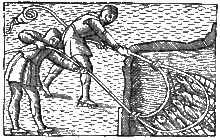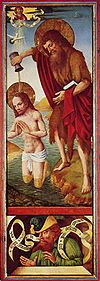Gentle driver

As Schonenfahrer Hanseatic merchants and sailors were referred from the Middle Ages to modern times, originally in the herring trade with the then Danish Scania (Danish and Swedish: Skåne ) and the local Vitten on the Scanian trade between Skanör and Falsterbo were active. As merchants in their hometowns they were grouped together in the local corporations of the Skåne drivers, through which they safeguarded their economic, political and social interests there. Corporations of the Schonenfahrer existed in the Wendish cities of the Hanseatic League on the Baltic Sea from Lübeck to Stettin , but also in the competing sister cities on the North Sea such as Hamburg and even inland, for example in Dortmund . The Schonenfahrer had their own seal, which in Lübeck showed three herrings on top of each other, later linked in half with the half double-headed eagle of the Holy Roman Empire to highlight the imperial German merchant.
Lübeck Schonenfahrer
 
Johannes altar of the Skåne driver |
The corporation of the Lübeck Schonenfahrer probably existed from the 12th century until 1853, when the merchants' corporations were combined in the Lübeck merchants . The exact beginning of the merger of the Lübeck long-distance traders has not been documented, but the corporation of the Schonenfahrer has been documented since 1363 and as early as 1380 the Bergenfahrer split off from the Schonenfahrers as the first further corporation. The Stockholm drivers, the Riga and Novgorod drivers also later split off from the Skåne drivers. Within the corporation of the Skåne drivers, the merchants belonging to it initially organized among themselves the processing and trading of the herring, which were in abundance off the coast of Scania, which was extremely important for Lübeck in the Middle Ages.
The Skåne drivers capable of being advised were held in high esteem among the merchants' corporations in Lübeck, even if they could not compete with the top- ranking circle society in terms of their social importance and political power development . Accordingly, they made proportionally fewer councilors and Lübeck mayors from their ranks , but as proven practitioners of navigation in the waters of the Baltic Sea in armed conflicts together with the members of the corporation of mountain drivers proportionally the highest proportion of Lübeck fleet leaders. As a large corporation, the Schonenfahrer were also an important pioneer of modern self-government in the economy and organized and controlled commercial training in Lübeck, the processes in the Lübeck port and from the 17th century maintained the Lübeck postal system in their Schütting at Mengstrasse 18 . The Schonenfahrer particular since Bürgerrezess of 1669 together with the other civic corporations to the constitutional reform of 1848, the composition of the Senate and the citizenry . The insignia of the Skåne drivers can still be found today as coats of arms on the side cheeks of the stalls of the Schiffergesellschaft or in the Lübeck museums, but also in the seal of the merchants, whose seal as a corporation unites all the seals of the corporations that have merged into it. In the St. Annen Museum you can find the altar wings as fragments of the Schonenfahrer altar originally from the Marienkirche by Bernt Notke and remnants of the church pews of this company, which give an idea of the wealth of the corporation in the late Middle Ages.
Stralsund Schonenfahrer
For the Stralsund merchants, the first trade relations with other countries with Denmark arose. This is also due to the fact that the Principality of Rügen and Western Pomerania were Christianized from Denmark . In addition, fishing for herring was of course a popular, profitable business for the people of Stralsund, and the geographical distance made it easier to travel to Skåne. The relationships are documented for the first time in 1249 and 1250. The Danish King Erich Plugpfennig instructed his coastal residents to leave the stranded ships of the Principality of Rügen undisturbed and to exempt them from beach rights . The instruction apparently also applied to Stralsund ships, this can be derived from the fact that a copy of the aforementioned document was kept in the Stralsund archive .
In 1276 the Danish King Erik V. Klipping authorized the people of Stralsund to appoint their own official for the time of the markets in Skåne. This had the task of settling all disputes between the merchants that did not fall within the royal jurisdiction. In 1277 the king confirmed the exemption from beach rights, in 1278 he granted duty exemption for the markets in Hvidanger , and until the end of the 14th century the privileges were confirmed several times. In 1320 King Christoph II granted the Stralsund Vitte in Skåne with additional rights. Waldemar III granted very extensive rights that no other Hanseatic city owned at the time . 1326. Every year from July 25th to November 11th, he allowed them to have blood jurisdiction exercised by a bailiff, to operate small shops and drinks, and to freely import and export goods in his empire at traditional customs tariffs. He also granted the people of Stralsund the right to set up their stalls and sell goods during the markets in Skåne; this referred to merchants, butchers, shoemakers and other citizens of the city.
After King Magnus of Sweden and Norway had secured rule over Skåne in 1332, the situation of the German Skåne drivers deteriorated. It was not until 1339 that Magnus confirmed the privileges. After Waldemar IV became the new Danish king, the people of Stralsund and Lübeck had their rights to Skåne confirmed by him, although Skåne was not in his hands at that time. This drew them the indignation of King Magnus and numerous tolerated attacks. A document from 1342 registers 18 cases of damage that the Stralsund people suffered from noble pirates, whereby herrings, salt, beer, hops, butter, stockfish, cloth and money were stolen.
When Waldemar IV reintegrated Scania into the Danish Empire in 1360, trade was again made more difficult for the cities. Waldemar met negotiations on the part of the Hanseatic League in 1361 with the pillage of Visby . Further disputes followed, and it was not until 1370 that the Hanseatic League achieved a victory over Denmark. In the Peace of Stralsund , the merchants were also confirmed their old privileges.
Schonenfahrer as corporations in other Hanseatic cities
According to Dollinger, there were companies in a total of eight Hanseatic cities that called themselves Schonenfahrer, including Deventer and Dortmund . In other cities, the long-distance traders involved in the herring business and the Scandinavian Fair also called themselves Denmark drivers or, if they did not operate the herring business on Skanör-Falsterbo, but on Dragør, Dragør drivers .
Hamburg
At the end of the 14th century there were three commercial corporations in Hamburg ; in addition to the Skåne drivers, the England drivers and the largest corporation of the Flanders drivers .
Cologne
The Cologne merchants with interests in trade with the southern Baltic region were united in the fraternitas danica , which was documented as early as 1246 .
Rostock
At the end of the 15th century there were five other merchant companies in Rostock in addition to the Schonenfahrers, including the Wiekfahrer , the Bergenfahrer and the Rigafahrer . The importance of the Schonenfahrer for Rostock is demonstrated by the fact that one of the city's younger councilors acted as Vogt of the Rostock Vitte in Falsterbo .
Szczecin
A list of members of the Marienbruderschaft der Schonenfahrer in the Pomeranian State Museum in Greifswald, begun in 1434, has come down to us from Stettin . There the Loitz family, who had become rich as fish merchants in Skåne, tried to monopolize the salt business as well as trading in fish .
literature
- Ernst Baasch: The Lübeck skipper drivers. Lübeck publishing house Otto Waelde, Lübeck 1922 ( Hansische Geschichtsquellen NF 4, ZDB -ID 503419-x ).
- Ahasver von Brandt : From the Skåne drivers to Lübeck. In: The car . 1959, pp. 23-29.
- Philippe Dollinger : The Hanseatic League. 2nd revised edition. Kröner, Stuttgart 1976, ISBN 3-520-37102-2 ( Kröner's pocket edition 371).
- Herbert Ewe (ed.): History of the city of Stralsund. H. Böhlau, Weimar 1984 ( Publications of the Stralsund City Archives 10, ISSN 0585-3958 ).
- Antjekathrin Graßmann (Ed.): Lübeckische Geschichte. 2nd revised edition. Schmidt-Römhild, Lübeck 1989, ISBN 3-7950-3203-2 .
- Wilhelm Stieda : The Schonenfahrer feast in Rostock. In: Hansische Geschichtsblätter. 19, 1890/91, ISSN 0073-0327 , pp. 115-150, especially p. 134.
Web links
swell
- ^ Lübeck port company: The port of Lübeck until the middle of the 19th century.
- ↑ Pomeranian Document Book , I, No. 503
- ^ Pommersches Urkundenbuch, II, No. 1092
- ^ Pommersches Urkundenbuch V, No. 3394
- ↑ Pommersches Urkundenbuch, VII, No. 4228, 4229
- ^ Hansisches Urkundenbuch II, No. 636
- ^ Hansisches Urkundenbuch II, No. 727
- ↑ The Hanse , p. 213
- ^ Dollinger, p. 213
- ^ Dollinger, p. 213
- ^ Dollinger, p. 213
- ↑ K. Schröder: In your walls there is harmony and general welfare , Rostock 2003, p. 41.

